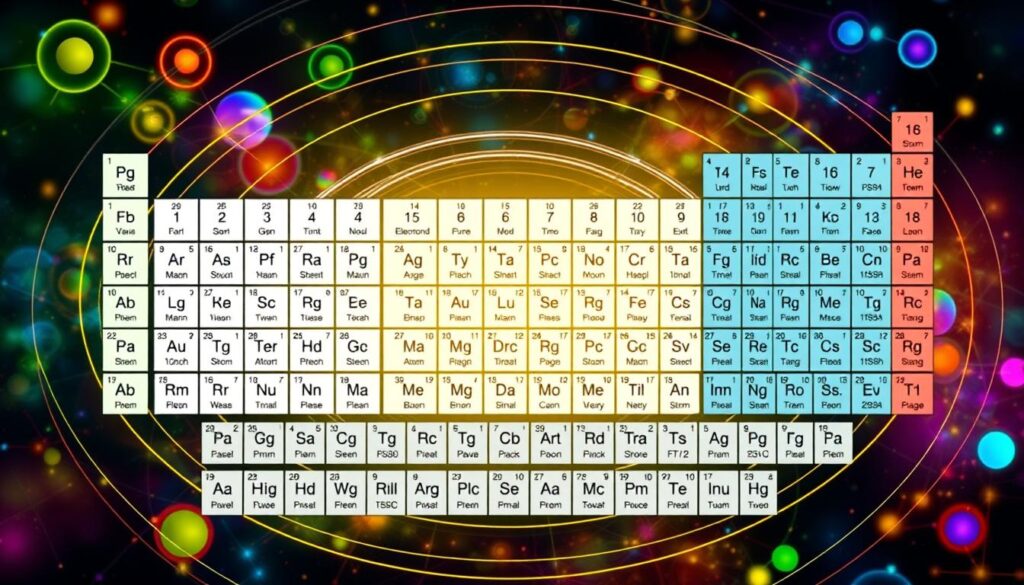Valence electrons are key to understanding chemical interactions. These electrons live in the outermost energy level of atoms. They play a crucial role in how elements react and bond12.
Finding valence electrons unlocks the secrets of chemical behavior. The periodic table reveals important info about electron configurations. Different groups have unique patterns that affect their reactivity13.
Learning to find valence electrons takes practice. You’ll explore electron setups and periodic table trends. This knowledge helps explain how atoms interact2.
Key Takeaways
- Valence electrons determine an element’s chemical properties
- The periodic table provides a roadmap for finding valence electrons
- Different element groups have unique electron configurations
- Electron counting varies across different chemical blocks
- Understanding valence electrons helps predict chemical reactions
Understanding Valence Electrons
Valence electrons are the stars of atomic interactions. They live in the outermost shell of an atom. These electrons shape how elements behave and bond4.
What Are Valence Electrons?
Valence electrons are the least tightly held electrons in an atom. They’re the most available for chemical reactions5. These electrons sit in the outermost shell, defining an element’s chemical properties4.
Importance in Chemistry
These electrons determine an element’s reactivity and bonding abilities. You can find their number by looking at the group number on the periodic table2.
- Alkali metals (Group 1) have 1 valence electron
- Carbon group (Group 14) has 4 valence electrons
- Noble gases (Group 18) have 8 valence electrons
Chemical Bonding Influence
Valence electrons drive chemical bonding and reactions2. Elements aim to achieve a stable electron configuration. This usually happens by filling their outermost shell2.
Transition metals have complex electron configurations. This makes their valence electron determination more challenging4. An element’s electrical conductivity depends directly on its valence electrons2.
The Basics of Electron Configuration
Electron configuration is key to finding valence electrons. It shows how electrons are arranged in an atom. This concept helps explain chemical behavior and bonding potential6.
What is Electron Configuration?
Electron configuration describes how electrons are arranged in an atom’s orbitals. It’s like a filing system for electrons. They’re organized based on energy levels and specific electron placement principles.
The Role of Quantum Numbers
Quantum numbers determine where electrons are located. Each electron has unique traits that define its position and energy level.
- Principal quantum number (n) defines the electron’s main energy level
- Angular momentum quantum number describes orbital shape
- Magnetic quantum number indicates orbital orientation
- Spin quantum number determines electron spin direction
Identifying the Highest Energy Level
The outermost shell holds valence electrons. These are vital for chemical interactions. Different orbital types can hold specific numbers of electrons:
| Orbital Type | Maximum Electrons |
|---|---|
| s orbital | 2 electrons7 |
| p orbital | 6 electrons7 |
| d orbital | 10 electrons7 |
| f orbital | 14 electrons7 |
A valence electrons calculator can help you find the number of outer shell electrons. This is crucial for predicting chemical interactions. It also helps understand bonding behavior.
Step-by-Step Guide to Finding Valence Electrons
Finding valence electrons can be easy with the right approach. The periodic table is your main tool for this task. Main group elements offer a simple way to count valence electrons81.
For main group elements, use the group number to find valence electrons. Sodium (Na) in Group 1 has 1 valence electron19. Transition metals need a different method due to their complex electron setup1.
For transition metals, look at the outermost S and D orbital electrons8. Different element groups have unique traits. Group 1 elements have one valence electron, while Group 2 has two9.
Use electron config charts for complex elements in the d-block. Learn more about valence electrons to improve your skills.
Advanced methods involve studying an element’s electron setup. The octet rule says atoms want eight electrons in their outer shell9. Practice will help you master finding valence electrons.
FAQ
What exactly are valence electrons?
How do I find the number of valence electrons using the periodic table?
Why are valence electrons important in chemistry?
How do valence electrons relate to electron configuration?
Can you give an example of finding valence electrons?
Are valence electrons different for transition metals?
How do valence electrons affect chemical bonding?
Source Links
- How to Find Valence Electrons – GeeksforGeeks – https://www.geeksforgeeks.org/how-to-find-valence-electrons/
- Valence Electrons – Characteristics and Determination of Valence Electrons – https://byjus.com/chemistry/valence-electrons/
- Using the periodic table, how can you tell how many valence electrons an element has? – https://chemistry.science.narkive.com/YnE9kH82/using-the-periodic-table-how-can-you-tell-how-many-valence-electrons-an-element-has
- What are Valence Electrons? | ChemTalk – https://chemistrytalk.org/what-are-valence-electrons/
- Step by Step Solution – https://www.vaia.com/en-us/textbooks/chemistry/chemistry-the-science-in-context-5-edition/chapter-8/problem-22-distinguish-between-an-atoms-valence-electrons-an/
- 2.7: Applications of Electron Configurations: Valence Electrons and Electron Dot Structures – https://chem.libretexts.org/Courses/Heartland_Community_College/CHEM_120:_Fundamentals_of_Chemistry/02:_Atoms_and_Elements/2.07:_Applications_of_Electron_Configurations_Valence_Electrons_and_Electron_Dot_Structures
- Electron Configurations – https://www.chem.fsu.edu/chemlab/chm1045/e_config.html
- Valence Electrons of Elements Explained: Definition, Examples, Practice & Video Lessons – https://www.pearson.com/channels/general-chemistry/learn/jules/ch-8-periodic-properties-of-the-elements/valence-electrons-of-elements
- Valence Electrons – GeeksforGeeks – https://www.geeksforgeeks.org/valence-electrons/
